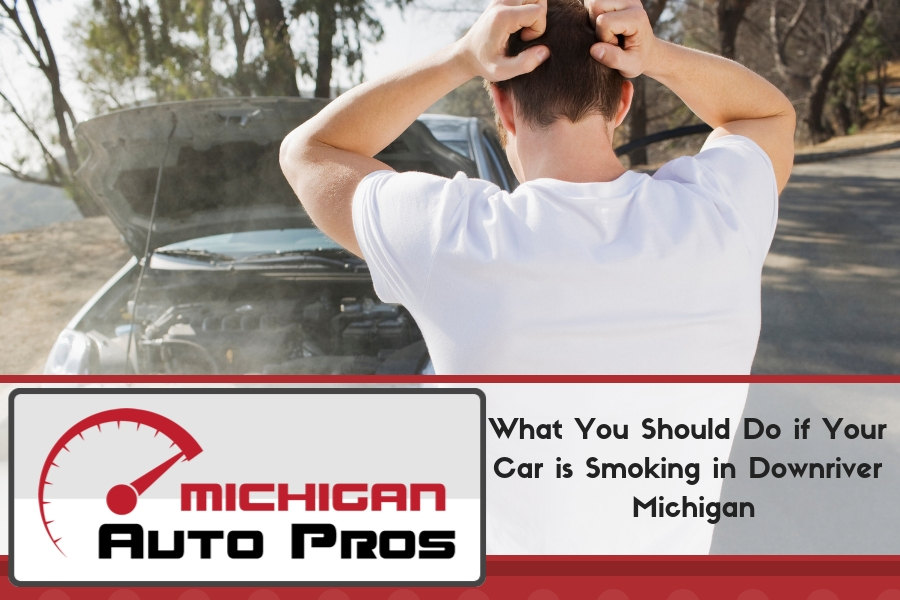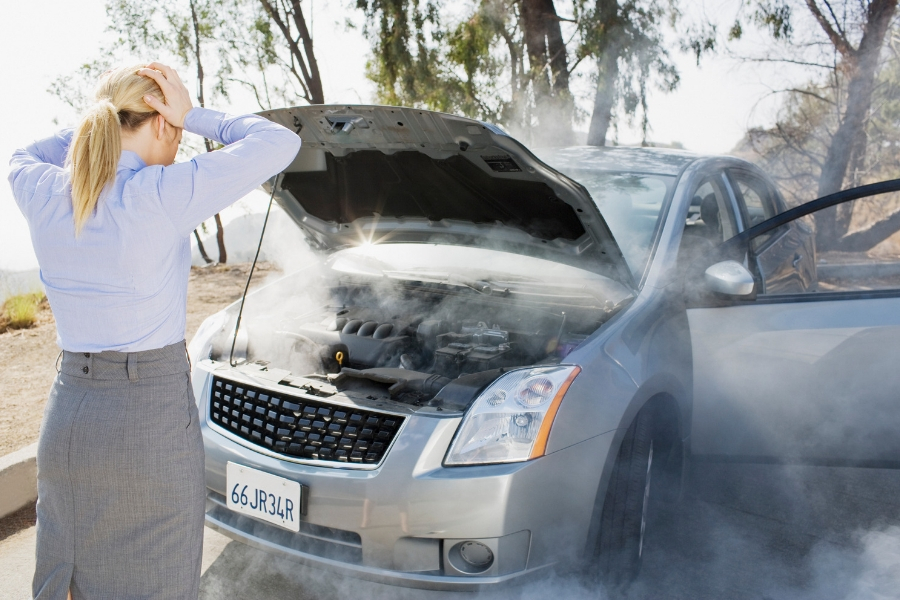Smoking isn’t just bad for your health, it’s bad for your car’s too. If your vehicle leaves you in the smoking section, there’s a good chance something has malfunctioned. Catching it sooner than later can help you dodge costly repairs. Read on to understand the reasons behind a smoky car and how to best respond and more importantly what to do if your car is smoking in Downriver Michigan.
What You Should Do if Your Car is Smoking in Downriver Michigan
Any car using gasoline creates smoke. In order to function, gasoline is combined with oxygen and injected into the car’s combustion chambers – generally four or more cylinders – in an atomized state. Each cylinder has a piston which moves up and down. When the piston reaches the highest point in the cylinder, the fuel mixture is fully compressed and ignited by the spark plug. This creates a mini explosion which forcefully drives the piston back down. Each piston is connected to a shaft, which converts the piston’s reciprocating motion into a more usable rotary motion that ultimately makes its way to your wheels.
At the top of the cylinder are two or more valves. One valve opens to allow the fuel mixture to enter the cylinder. After it has burned, another valve opens to allow the remaining gasses to exit. These valves play a tremendous role in your vehicle’s emissions. The valves are timed to open only so far, and for a very specific interval. Deviating from this timing can increase emissions, which translates to smoke.

Smoke and Mirrors
Today’s cars emit very little visible smoke. Glancing in your rearview mirror and noticing a trail of black smoke is enough to alarm most drivers. Truth is, all cars emit some smoke, but the volume and color are telling. Tailpipe emissions are generally more visible upon startup – especially on a cold morning. The white plume you see bellowing from your car’s behind consists largely of condensation that has built up inside the exhaust system and is burning off. Most what you see is water vapor – steam – not smoke. The visible emissions generally taper off as your motor warms and settles into its cadence. If while driving you see a trail of emissions, you’re going to need to dig a little deeper to get to the root of the problem.
White Smoke
If after startup your car’s still emitting white smoke, you may be faced with a problem. White smoke can be associated with lean fueling (the air-to-fuel ratio greatly favors air) and this can be traced to an error with your car’s ECU. The ECU controls the vehicle’s fueling and if it is faulty or damaged, an inefficient burn occurs and results in the unsightly white smoke. And while the ECU decides how much air and fuel reach the engine, the injectors are responsible for delivering it. Virtually all cars today use fuel injection, and a damaged or worn injector will result in an incomplete burn. Faulty injectors are a common source of excess smoke but are fortunately inexpensive to replace.
Another cause of excess white smoke can be traced to your car’s cooling system. Throughout your engine are channels where coolant flows to whisk away a buildup of heat. Occasionally these may leak, and coolant enters the engine. The result is a frothy white, odorless smoke. If you see this, check your coolant levels. A frequent need to top off the coolant reservoir is a surefire indication that the system is leaking.
Black Smoke
While white smoke can be an indicator of a lean fuel mixture, black smoke is often a sign that your fueling is too rich. If your engine is running rich, it means there is too much fuel being delivered to the engine. An engine that’s burning too much fuel will often spew black smoke. An excess of carbon creates the black tint, and the smoke is essentially unburned fuel.
There are a couple of common reasons a car may emit black smoke. Your car’s fueling is carefully regulated. If you see black smoke, check your air filter to ensure it is clean and allows air to flow freely. Ensure that your fuel lines are not clogged. A faulty fuel pressure regulator is another problem area that can easily translate to excess smoking. Additionally, there are several sensors throughout your car that provide feedback to the ECU in order to help it determine the best air-to-fuel ratio. Should one of these sensors go bad, the result is often improper fueling and subsequent smoke.
Grey Smoke
Smoke with a grey or bluish tint to it isn’t great news. It’s one of the first indications that your engine is burning oil, which could suggest a crack in the engine block, damaged valve guides, or faulty piston rings. Cars with turbochargers also provide an additional point for oil to enter the combustion chamber. If you notice black smoke, check to ensure your oil isn’t low, and make note of any increased oil consumption. Although somewhat uncommon, fluid from an automatic transmission may find its way into the engine as a result of a faulty transmission vacuum modulator and produce black smoke at the tailpipe. None of these are inexpensive repairs.
Before jumping to conclusions however, you might want to consider getting your positive crankcase ventilation or “PCV” valve checked. This valve re-routes harmful emissions back into the cylinder to be burned off in the combustion process. Occasionally, these valves become stuck and a buildup of pressure results which can cause oil leaks that will lead to smoky emissions. Luckily, the PCV valve is an inexpensive repair able to be performed in a timely matter at nearly any repair shop.
Smoke pouring from the tailpipe will alarm most drivers in Downriver Michigan – and rightfully so. Burning oil is a precursor to catastrophic engine damage, and faulty ECU’s aren’t cheap to replace. Fortunately, the ASE-certified technicians at Good Care Auto in Downriver Michigan have decades of experience diagnosing and repairing everything from piston rings to PCV valves. They provide fast, accurate estimates and affordable repairs for all makes and models including import and luxury cars and trucks. If you notice any unusual emissions coming from your car, don’t let it go up in smoke. Call Good Care Auto at (734) 285-1188 and schedule an appointment today!
